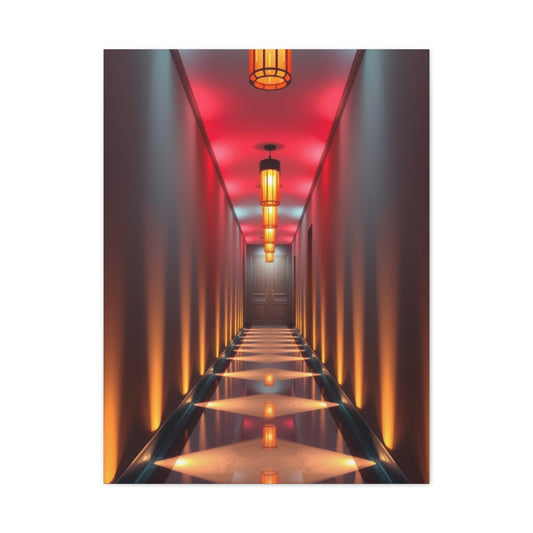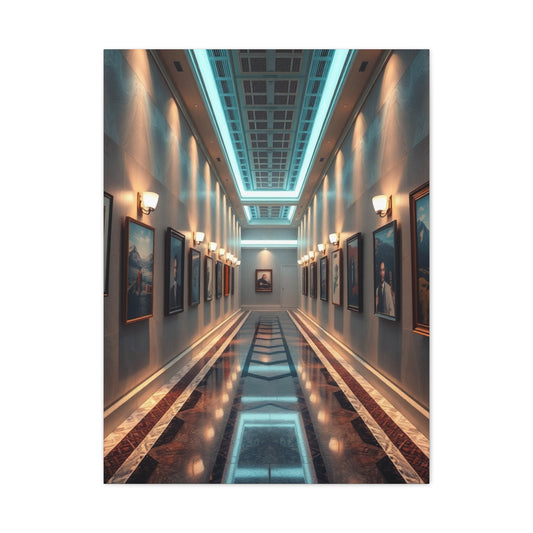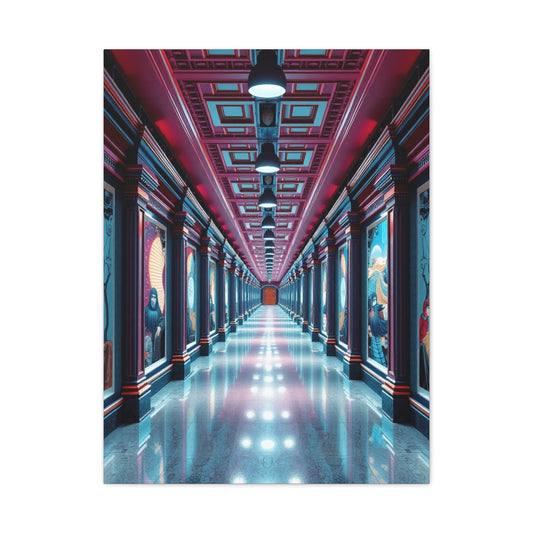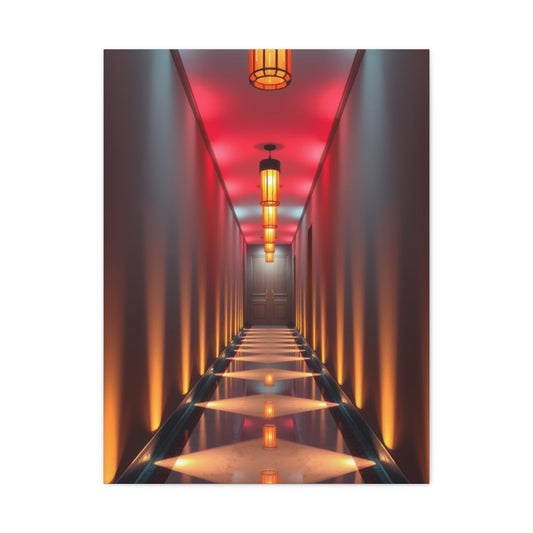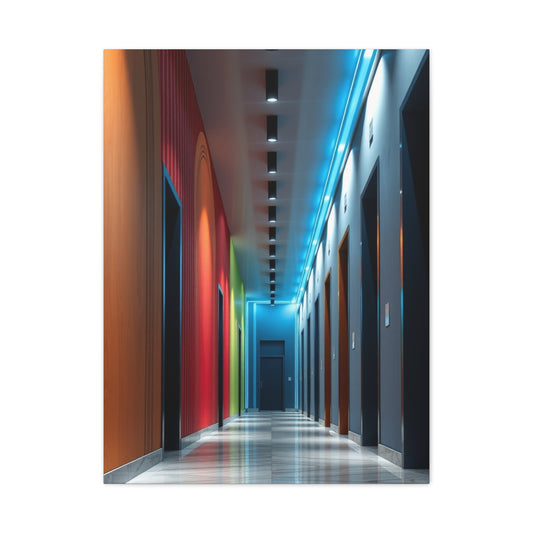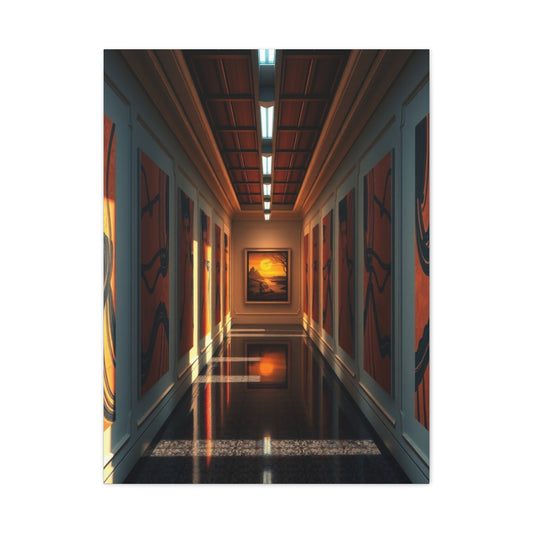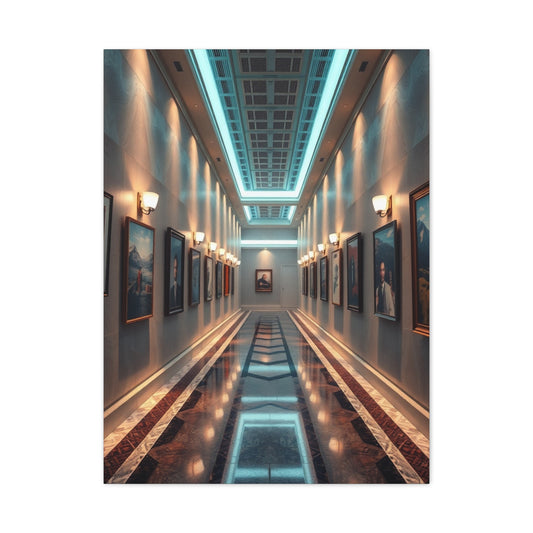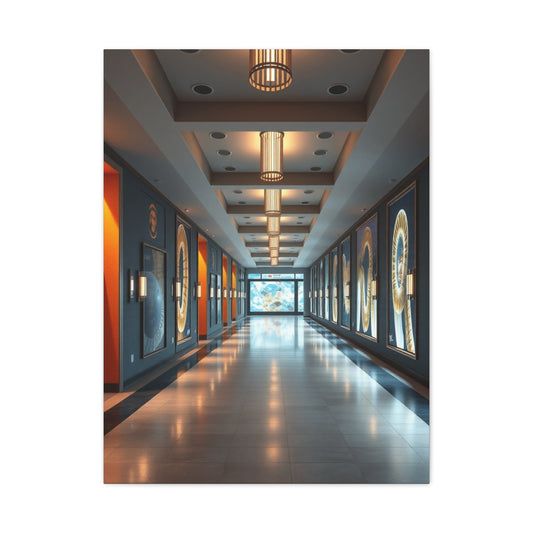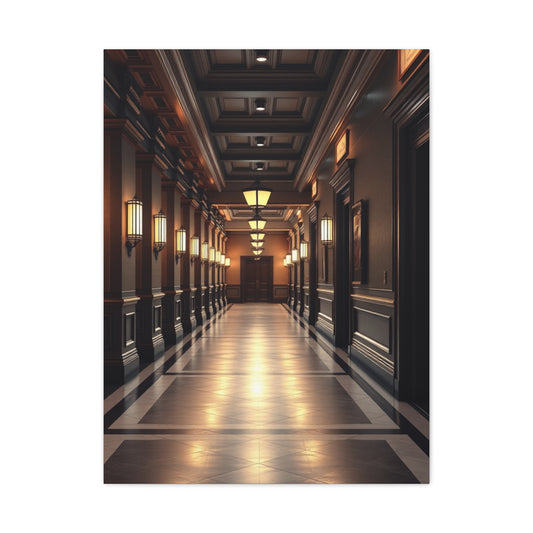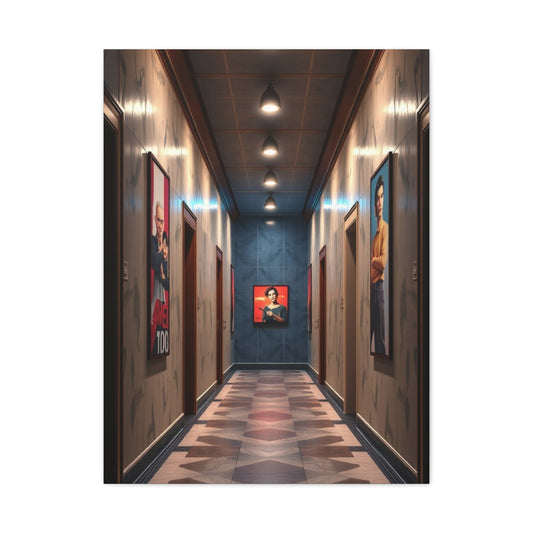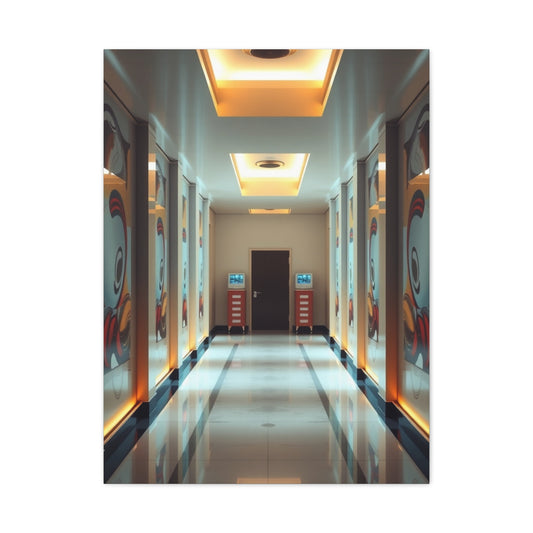Inspiring Hallway Wall Art Ideas for Stylish Interiors
Hallways are often perceived as transitional areas, mere conduits connecting one room to another. Yet with thoughtful decoration, especially through the integration of wall art, these spaces can metamorphose into intimate galleries filled with character, charm, and elegance. A carefully adorned hallway can shape the ambiance of an entire home, introducing subtle moods, colors, and textures that linger in memory long after someone has passed through.
Understanding the Importance of Wall Art in Hallways
Unlike living rooms or bedrooms, hallways rarely contain much furniture. Their blank walls offer immense potential, functioning like untouched canvases awaiting expression. Because of their simplicity, even a single painting or print can dramatically alter the environment. The selection of art becomes not just an aesthetic decision but also a statement that influences perception and atmosphere.
When visitors enter your home, the hallway is often among the first spaces they encounter. Wall art here sets the tone, whispering stories about your personality, your taste, and the world you want to create. Whether it is a vibrant abstract, a soothing landscape, or a captivating portrait, each choice shapes the visual dialogue of the space.
Selecting Wall Art That Harmonizes with the Interior
Every hallway carries its own character. Some exude tranquility through pale hues and soft lighting, while others radiate energy with bold lines and strong architectural features. The wall art you select should complement these qualities rather than clash against them.
If the hallway has a calm and minimalistic aura, artworks with muted palettes, serene imagery, or delicate brushstrokes will extend that impression. On the other hand, a natural or classic interior can be accentuated with pieces that highlight organic textures, intricate details, or timeless motifs. In a setting defined by stark whites and grays, artworks of almost any color can burst into prominence, adding vitality and dynamism.
Harmony between wall art and the interior design ensures that the hallway feels like a coherent extension of the home rather than an afterthought. This is where subtle discernment plays a role: noticing how shades, frames, and proportions converse with the walls and lighting.
The Emotional Resonance of Art in Transitional Spaces
Hallways may be passageways, but they are also moments of pause. As people walk through, their eyes are naturally drawn to the surrounding walls. This fleeting engagement becomes an opportunity for contemplation, inspiration, or comfort.
Imagine strolling through a hallway adorned with an expressive abstract—its swirls of color suggesting movement and emotion. Each time you pass, you might interpret something different, allowing the artwork to evolve in meaning. Or perhaps a delicate watercolor landscape reminds you of quiet countryside paths, offering a breath of tranquility during busy days.
Wall art in hallways does more than decorate; it resonates. It becomes part of the everyday rhythm, enriching routine moments with beauty and significance.
Considering Scale and Placement
Choosing the right size of artwork for a hallway is essential. The proportions of the piece determine whether it feels balanced or overwhelming. Large-scale art has power when displayed on the wall at the end of the hallway, where it can be admired from a distance and acts as a natural focal point. In contrast, side walls often require medium-sized pieces that can be appreciated up close as one walks by.
Placement is equally vital. Hanging a painting too high can create discomfort, while positioning it too low may disrupt the flow of vision. The optimal height usually aligns with natural eye level, ensuring effortless engagement. Orientation also matters. Portrait works can elongate the perception of space, while landscape pieces can broaden the hallway’s dimensions.
Subtle awareness of these factors creates an environment where artwork feels integrated rather than imposed.
Embracing Unique Styles and Themes
Hallways provide an opportunity to experiment with styles that might feel too daring for larger living spaces. Their transitional nature encourages diversity and exploration. Abstracts, for instance, thrive in hallways because of their ability to spark curiosity without dictating a single narrative. Geometric forms, impressionistic brushwork, or dreamlike imagery all find a natural home in these liminal areas.
Themes can also be woven into the design. A series of botanical prints might create a naturalistic atmosphere, while photographs of cityscapes might add urban sophistication. Even eclectic collections—where each piece is distinct yet connected through a common tone—can form a gallery-like allure that enriches the journey down the corridor.
The Subtle Art of Framing
Frames are often overlooked, yet they can dramatically influence the presentation of wall art. A sleek black frame might lend contemporary refinement, while ornate carved wood may evoke classical elegance. In minimalist hallways, frameless canvases or floating frames can maintain visual lightness, preventing the space from feeling crowded.
Consistency in framing can create unity, especially when displaying multiple pieces. However, intentional variation—such as mixing different frame textures—can introduce layers of interest that reflect individuality.
The Role of Light in Enhancing Art
No hallway wall art can truly flourish without proper lighting. Natural light, when available, enhances vibrancy and reveals subtle details. However, artificial lighting can be just as effective. Adjustable wall sconces or discreet ceiling spotlights can highlight each piece, drawing attention and creating dramatic shadows that add depth.
In narrow hallways, carefully positioned lighting prevents artwork from being lost in gloom. Warm light, in particular, can accentuate colors and evoke intimacy, whereas cooler light may highlight precision in line and form. The interaction between illumination and art transforms simple decoration into a multisensory experience.
Personal Connection to Artwork
Beyond style, size, and placement lies perhaps the most significant factor: personal resonance. Art in the hallway should not merely impress guests; it should speak to you. These are works you will encounter multiple times each day. Selecting pieces that evoke fond memories, embody aspirations, or mirror your imagination ensures that your hallway becomes a space of personal connection rather than superficial ornament.
Perhaps it is a painting that reminds you of childhood summers, a sketch that captures a fleeting moment of serenity, or an abstract that resonates with your inner rhythm. These connections infuse the space with authenticity and meaning.
Evolving the Hallway Over Time
The beauty of hallway wall art lies in its adaptability. Unlike more permanent design elements, artworks can be rotated, replaced, or rearranged to refresh the space. This allows for evolving creativity, seasonal changes, or even temporary exhibitions of new pieces you acquire.
Over time, the hallway becomes a living canvas, reflecting growth, change, and shifting inspiration. It is not a static gallery but a dynamic expression of life’s unfolding narrative.
Choosing the Right Size and Placement of Hallway Wall Art
Hallways are fascinating spaces to decorate because they are inherently dynamic. Unlike living rooms or dining areas, where people linger, hallways are meant for movement. The artwork you place here is encountered fleetingly yet repeatedly, which makes scale and placement especially critical. Even the most exquisite piece can feel out of balance if its proportions are unsuitable or if it is positioned awkwardly. By carefully considering the size of the wall art and its arrangement, you can turn a hallway into a captivating, harmonious gallery that enhances the rhythm of daily life.
The Relationship Between Scale and Perception
The size of a piece of wall art determines how it interacts with the architectural proportions of the hallway. Large works immediately command attention, acting as focal points, while smaller pieces provide delicate accents that invite closer inspection. The decision between the two is not only aesthetic but also spatial.
A hallway with broad walls and generous width can host sizable artwork that makes a bold statement without overwhelming the environment. On the other hand, narrow corridors demand restraint. In such settings, immense canvases may feel suffocating, while medium or smaller works allow for easier appreciation at close range.
This principle of scale reflects the human experience of perspective. When people move through hallways, their sightline shifts continuously. A piece at the end of the corridor can be observed from afar, allowing grandeur in size. Conversely, pieces along the side walls are encountered as one passes, requiring proportions that do not strain the viewer.
Positioning Artwork on the End Wall
The wall at the end of a hallway is among the most strategic places to display art. This surface naturally captures the gaze, serving as a visual conclusion to the passage. A large painting or striking print hung here functions almost like a beacon, guiding movement through the corridor.
Because this artwork is typically seen from a distance, it can afford to be expansive in both scale and detail. Viewers will approach it gradually, noticing new textures and nuances as they draw nearer. A single monumental piece here not only defines the hallway but also lends coherence, anchoring the flow of the space.
Placement height is especially significant on the end wall. Aligning the center of the artwork with natural eye level ensures comfort. This measurement should be taken from the vantage point of someone standing at the hallway’s entrance, since that is where the piece is first observed. Hanging it too high might detach it from the field of vision, while too low a placement can make the space feel truncated.
Arranging Artwork Alongside Walls
When artwork is hung on the side walls of a hallway, the experience shifts. Instead of being drawn to a distant focal point, viewers interact with the pieces as they pass. This creates an intimate engagement, where details are seen up close and textures reveal themselves more vividly.
For this reason, medium-sized pieces often work best on side walls. They are large enough to carry visual weight yet not so massive that they dominate the space. Small artworks can also thrive here, especially when arranged in a thoughtful sequence.
Orientation deserves attention, too. Portrait pieces emphasize verticality, which can elongate the impression of a narrow hallway, while landscape orientations extend the perception of breadth. The choice depends on whether you wish to exaggerate height or width.
Spacing between multiple artworks is equally important. Crowding pieces too close together creates visual noise, while excessive distance may feel disconnected. A rhythm of consistent intervals helps achieve balance, mimicking the cadence of steps taken along the passage.
The Influence of Corridor Dimensions
Hallways differ dramatically in scale: some are broad and sunlit, while others are narrow and dimly lit. Understanding the spatial qualities of the corridor is crucial for deciding how to size and arrange wall art.
In wide hallways, artwork can be placed at varying heights without creating discomfort. Larger pieces can be accommodated easily, and even sculptural wall art may fit without intruding on movement. Meanwhile, in narrow corridors, restraint is essential. Medium or small pieces aligned at eye level preserve ease of passage while still offering visual delight.
Ceiling height also influences perception. Tall ceilings allow for vertically oriented works or stacked arrangements, creating grandeur. Lower ceilings require more horizontal emphasis, as vertical expansion may exaggerate the compression of space.
The Dialogue Between Single and Multiple Pieces
A solitary large artwork creates clarity and focus, while a sequence of smaller works generates rhythm and variety. Both approaches can be effective, but each sets a different mood.
One large piece becomes a statement, projecting dominance and confidence. It asserts itself as the defining element of the hallway. Multiple pieces, however, create a narrative. A series of related prints, for example, invites the viewer to journey through the hallway with curiosity, observing continuity and progression.
When curating multiple pieces, consistency in frame type or color palette can provide cohesion. Alternatively, deliberate variation can create eclecticism, reflecting individuality and spontaneity.
Considering Line of Sight
Unlike other rooms, hallways are experienced primarily while walking. This makes line of sight a central consideration. As you move through, artworks should appear comfortably within your field of vision, neither straining the neck upward nor requiring awkward glances downward.
Aligning multiple pieces along a horizontal line parallel to the viewer’s eyes creates an impression reminiscent of a gallery exhibition. This arrangement provides both ease and elegance, allowing the viewer to absorb each work naturally in motion.
Corners deserve special consideration, too. An artwork placed just before a turn can surprise the eye, creating intrigue and anticipation. However, balance is key; corners should not feel cluttered, as this disrupts the fluidity of movement.
The Interplay of Orientation and Narrative
Orientation does more than define dimensions—it conveys narrative. A vertical piece may suggest aspiration, reaching upward, while a horizontal one can evoke expansiveness and calm.
In hallways, the choice of orientation also determines how the eye travels. Vertical works may slow the gaze, encouraging pause, while horizontal works encourage sweeping movements across the wall. Combining both orientations can produce rhythm, provided they are arranged thoughtfully.
A hallway adorned with alternating vertical and horizontal works creates visual cadence, much like musical notes in composition. This rhythm enlivens the space, offering moments of pause and flow.
The Psychology of Proximity
Because hallways are passageways, artwork here is often viewed up close. Unlike large canvases in a living room, which are observed from a seated distance, hallway art interacts directly with the body as it moves past. This proximity demands attention to detail. Brushstrokes, textures, or fine lines become significant, as they are easily noticed.
Choosing artworks with intriguing surface qualities can heighten this experience. A textured canvas, a layered print, or even mixed-media work offers richness when observed within arm’s length. This transforms the simple act of walking down the hallway into a sensory exploration.
Adjusting Placement with Lighting
Lighting conditions influence not only how artworks appear but also where they should be placed. A hallway bathed in natural light may allow for flexible placement, while dim corridors require strategic positioning under artificial fixtures.
Avoid placing artworks where glare from direct sunlight will obscure them. Similarly, artworks positioned too close to artificial light may suffer from harsh reflections. Ideally, placement should harmonize with the light, allowing colors and textures to emerge clearly without distortion.
Adjustable lighting—such as track lights or sconces—can be directed precisely onto each piece, enhancing visibility and creating a curated atmosphere. In such settings, even smaller works gain prominence through careful illumination.
Curating Balance in Asymmetry
Perfect symmetry in artwork arrangement is pleasing but not always necessary. Sometimes asymmetry creates intrigue, adding dynamism to the hallway. A single large piece balanced by two smaller works on the opposite side, for example, creates equilibrium without rigidity.
The key lies in visual weight. Even if sizes differ, balance can be achieved through color, frame style, or positioning. An off-center arrangement can feel intentional and artistic when the elements are in dialogue rather than competition.
The Flexibility of Rotation
One of the joys of hallway decoration lies in flexibility. Unlike structural features, artworks can be shifted, rotated, or replaced. Experimentation is encouraged. Try relocating a piece from the side wall to the end wall, or replacing a single large canvas with a sequence of smaller ones. Each alteration brings new life, preventing monotony and allowing the hallway to evolve with changing tastes.
Rotation also prevents visual fatigue. Seeing the same artwork repeatedly in a high-traffic area can sometimes diminish its impact. By rotating pieces, you renew engagement, keeping the hallway stimulating and fresh.
Hallway Wall Art Ideas for a Stylish and Inviting Space
A hallway is more than a corridor connecting rooms; it is a canvas for expression, a passage that frames the rhythm of daily life. Decorating its walls with art elevates this overlooked space into an inviting gallery, offering beauty and resonance each time one passes through. The key lies not only in choosing the right artworks but also in arranging them thoughtfully to create harmony, depth, and personality. Hallways may appear simple, but within their restrained dimensions lies an opportunity for sophistication and imagination.
The End Wall as a Focal Point
The wall at the end of a hallway naturally draws the eye. It functions as a visual destination, a point where movement converges. Placing an artwork here gives the hallway a sense of purpose and conclusion.
Large-scale pieces often work best in this position. A striking abstract canvas, a panoramic photograph, or a bold modern print will captivate attention from afar and invite closer inspection as one approaches. The artwork becomes a beacon, enriching the journey down the corridor.
Placement height is crucial here. The center of the piece should align comfortably with eye level when viewed from the entrance. This ensures that the artwork feels anchored rather than floating too high or sinking too low. A balanced focal point creates order and poise, enhancing the overall spatial experience.
Side Walls as Linear Galleries
While the end wall serves as a natural anchor, the side walls of a hallway offer a different possibility: rhythm. Displaying several pieces side by side evokes the atmosphere of a gallery, where each artwork contributes to a larger narrative.
Arranging artworks in a horizontal line at eye level creates visual continuity. The viewer moves through the hallway as though strolling through an exhibition, observing each piece in sequence. Consistency in spacing enhances this effect, creating calm order, while slight variations can add spontaneity.
The number of pieces matters too. A trio can feel balanced, while a sequence of five or more suggests progression. Even two works side by side can create dialogue, their relationship hinting at stories and contrasts. The key lies in ensuring that no piece overwhelms the others, but instead they coalesce into a unified impression.
Balancing Color and Interior Tones
Wall art is not isolated; it interacts with its surroundings. A hallway defined by neutral tones—white, gray, beige—offers a versatile backdrop where artworks of any palette can shine. Vibrant colors provide contrast, enlivening the passage, while subtle hues blend harmoniously, creating tranquility.
When choosing colors, consider the emotional undertones they introduce. Blues and greens often evoke serenity, while reds and oranges radiate warmth and vitality. Black-and-white works, whether photographs or graphic prints, offer sophistication and timeless elegance.
Frames play a significant role here as well. A dark frame can anchor a light-toned piece, while a minimalist white frame may allow vivid colors to dominate. The interaction between artwork, frame, and wall color shapes the overall aesthetic cohesion of the hallway.
Creating Intimacy in Narrow Hallways
Narrow hallways pose particular challenges but also unique opportunities. Because the walls are close, artworks are viewed at short range, making detail paramount. Smaller or medium-sized works are often more suitable here, as they can be appreciated without overwhelming the confined space.
Delicate sketches, textured prints, or small canvases invite close attention, rewarding the viewer with nuance. A single piece in a narrow corridor can feel intimate, while a sequence of smaller works arranged vertically or horizontally can create rhythm without overcrowding.
Lighting becomes especially important in narrow spaces. Subtle wall sconces or directed spotlights can prevent shadows and highlight details, ensuring the hallway feels intentional rather than claustrophobic.
Creating Drama in Long Hallways
A long hallway can feel monotonous if left bare, but with wall art, it becomes an immersive journey. Here, rhythm and spacing take precedence. Rather than placing a single focal piece, consider a sequence of artworks spaced evenly along the length of the walls.
This arrangement creates momentum, leading the viewer forward with anticipation. Each piece becomes a chapter in a visual story, offering variety without overwhelming. The distance between artworks should be adjusted carefully. Too much space leaves emptiness, while too little creates clutter. A measured interval balances openness with engagement.
The character of the artworks can vary while still maintaining cohesion. A mix of abstract canvases, photographic prints, and delicate illustrations may work together if unified by a consistent palette or theme. This curated diversity keeps the journey lively while preserving harmony.
Abstract Art as a Hallway Companion
Abstract artworks thrive in hallways. Their non-representational nature leaves room for interpretation, inviting fresh reflections each time one passes. They are also versatile, suiting both minimalistic interiors and eclectic ones.
A series of abstract works in varying tones can balance the length of a corridor, while a single large abstract on the end wall can establish dominance. Abstract art’s adaptability ensures that it never feels static; instead, it grows with the space, reflecting shifts in perception and mood.
Experimenting with textures in abstract art—layered paint, mixed media, or unconventional materials—adds depth, which becomes especially striking in hallways where artworks are viewed up close.
Playing with Asymmetry and Unexpected Placement
Although symmetry is often pleasing, hallways also benefit from asymmetry. Hanging a single artwork slightly off-center, or pairing a large piece with a smaller one nearby, can create intrigue. This unexpected arrangement disrupts predictability, encouraging viewers to engage more actively.
Corners, too, offer opportunities. Placing a piece just before a turn or at a junction can surprise the eye, offering delight where least expected. The challenge is to maintain balance: asymmetry must feel intentional rather than careless.
Layering with Mixed Styles
Hallways provide a chance to experiment with diversity. Unlike living rooms, which often require consistency, corridors can accommodate eclectic collections. A mixture of photography, abstract canvases, vintage prints, and even three-dimensional wall sculptures can coalesce into a rich, layered display.
The key lies in finding subtle connections—perhaps a recurring color, theme, or mood. These threads bind the collection together, preventing it from appearing haphazard. Such layering creates a hallway that feels curated, personal, and dynamic.
The Role of Lighting in Stylish Hallways
Art cannot exist in isolation from light. Proper illumination transforms simple decoration into an atmosphere. In hallways, where natural light may be limited, artificial lighting becomes an ally.
Wall sconces positioned beside artworks cast gentle glows, while recessed ceiling lights can spotlight specific pieces. Adjustable track lighting allows for versatility, highlighting different artworks as the hallway evolves. The color temperature of light also matters: warm tones evoke intimacy, while cooler tones enhance clarity and crispness.
Experimenting with shadow is another way to add drama. A piece subtly lit from one side may cast elongated shadows, enriching depth and intrigue. Light, therefore, becomes not just functional but artistic in its own right.
Elevating Simplicity with a Single Statement Piece
Sometimes restraint creates the strongest impression. A single painting, positioned thoughtfully in a hallway, can exude power and clarity. Instead of dispersing attention across multiple works, the focus rests entirely on one piece, allowing it to breathe and resonate.
This approach works particularly well in minimalistic interiors, where simplicity reigns. The chosen artwork becomes an anchor, shaping the entire atmosphere of the corridor. To enhance this effect, ensure generous space around the piece, avoiding competing elements.
Curating Seasonal or Rotational Displays
One way to keep a hallway stylish is through evolution. Unlike furniture, which remains fixed, wall art can be rotated. Seasonal displays bring freshness: lighter, airy works in summer; deeper, richer tones in autumn and winter. This fluidity keeps the hallway dynamic, preventing visual fatigue.
Rotating art also allows for personal experimentation. Trying different arrangements, styles, or orientations over time can reveal unexpected harmonies. A hallway, in this sense, becomes a living gallery—constantly renewed, always engaging.
The Personal Dimension of Hallway Art
Beyond style and placement, the most significant factor in creating a stylish hallway is personal connection. Art should not merely impress; it should resonate. The hallway is a daily passage, a space encountered repeatedly. The artworks displayed here should reflect fragments of memory, imagination, or aspiration.
Whether it is a painting that echoes distant landscapes, a photograph that captures fleeting joy, or an abstract that stirs quiet contemplation, personal resonance ensures authenticity. A stylish hallway is not merely visually appealing; it is meaningful, imbued with individuality.
Decorating Narrow and Long Hallways with Wall Art
Hallways, by their very nature, are transitional spaces. Yet, when approached thoughtfully, they can transcend this functional role to become corridors of artistic expression. Narrow and long hallways, in particular, present distinct challenges and opportunities. Their constrained width or extended length demands careful consideration of scale, composition, and visual rhythm. When executed with intention, wall art transforms these corridors from simple passageways into immersive, stylish spaces that engage the eye and enrich daily experience.
Understanding the Challenges of Narrow Hallways
Narrow hallways present a unique spatial puzzle. The confined width restricts movement and limits the viewer’s perspective. Large, imposing pieces can feel overwhelming, encroaching on physical space and creating visual tension. Conversely, small-scale works risk being lost amid the limited breadth, diminishing their impact.
The key lies in proportion. Medium or small-sized artworks tend to perform best in these environments, allowing close-up viewing without overwhelming the corridor. Choosing the right scale ensures that each piece can be appreciated intimately, rewarding the viewer with subtle detail and texture that might otherwise be overlooked in larger spaces.
Creating Focal Points in Narrow Corridors
Even in tight spaces, focal points are essential. A well-placed artwork can direct attention and provide a visual anchor. This may be a slightly larger piece positioned at the midpoint or end of the hallway, drawing the eye along the corridor. Alternatively, a series of smaller pieces arranged in sequence can create a rhythmic progression that naturally guides movement.
The idea of visual hierarchy is crucial. By strategically arranging pieces according to size, color intensity, or complexity, a narrow hallway can feel dynamic rather than monotonous. A central artwork may serve as a highlight, while flanking pieces offer supportive context, enhancing the overall narrative of the corridor.
Leveraging Vertical Space
In narrow hallways, vertical orientation can be particularly effective. Tall, slender pieces draw the eye upward, emphasizing height and creating an impression of spaciousness. Stacked arrangements of smaller works can also achieve this effect, generating a sense of rhythm and continuity.
Verticality not only affects perception but also encourages engagement. As viewers move along the corridor, their gaze naturally follows the vertical progression, fostering interaction with the artwork. This approach makes the hallway feel less constricted and more expansive, despite physical limitations.
Color, Contrast, and Visual Depth
Color plays a critical role in narrow spaces. Light tones can open up a corridor, making it feel more spacious and airy. Pastels, soft neutrals, and muted hues contribute to a sense of calm and lightness. Conversely, dark, saturated colors can add drama, but must be used judiciously to avoid visual compression.
Contrast can also enhance perception of depth. Placing artwork with lighter tones on one side and slightly darker or more saturated pieces on the opposite side can create dimensionality. Subtle gradations of color within a sequence of pieces add visual interest without overwhelming the corridor.
Lighting for Narrow Hallways
Proper illumination is paramount in narrow corridors. Poor lighting can flatten the perception of space and obscure the intricacies of the artwork. Wall-mounted sconces, directional spotlights, or recessed ceiling lights provide flexibility and control, highlighting individual pieces while maintaining overall harmony.
Soft, warm lighting often complements intimate spaces, emphasizing textures and details. Adjustable fixtures allow for rotation and focus, ensuring that each artwork is showcased effectively. Layering light, such as combining ambient ceiling light with directed accent lighting, creates depth and sophistication.
Sequencing and Rhythm in Narrow Hallways
The arrangement of multiple pieces in narrow hallways requires careful attention to sequencing and spacing. Even intervals between artworks provide a sense of order, while slight variations can create intrigue and prevent monotony.
The rhythm should correspond with the viewer’s movement. Pieces aligned along eye level, with subtle variations in height or frame size, engage the observer’s gaze naturally. This creates a flow that mirrors the physical journey through the corridor, transforming walking into a contemplative experience.
Decorating Long Hallways: Maximizing the Journey
Long hallways pose different challenges from narrow ones. Extended corridors risk monotony, appearing endless or sterile without intervention. Wall art introduces variation, focus points, and visual cadence, breaking the expanse into engaging segments.
Spacing is critical in long hallways. Artworks should be arranged to create moments of interest while leaving enough breathing room between pieces. Too much space can create emptiness; too little can feel cluttered. A measured, deliberate interval allows the corridor to feel dynamic yet balanced.
Creating Visual Anchors
Visual anchors in long hallways serve as touchstones for the viewer. Larger works positioned strategically at intervals or at the end of the hallway create natural pauses, drawing attention and providing coherence. These anchors establish a sense of progression, helping the viewer navigate the space both physically and visually.
Secondary pieces can complement anchors, maintaining rhythm and guiding movement. Variation in size, style, or color between anchors and supporting works creates depth and complexity, ensuring that the hallway maintains interest from entrance to exit.
Employing Mixed Media and Textural Variation
Long hallways provide opportunities to experiment with texture and medium. A combination of paintings, prints, photographs, and even subtle sculptural elements adds richness. Textural variation engages the viewer’s senses and creates layers of perception, encouraging repeated exploration of the corridor.
Even within a limited color palette, diverse textures—matte, gloss, canvas, or layered mixed media—introduce subtle differentiation. This interplay transforms a simple wall into an evolving visual landscape, ensuring that the hallway never feels static.
Balancing Symmetry and Asymmetry
Symmetry often provides a sense of order, while asymmetry introduces movement and tension. In long hallways, combining both strategies can produce compelling results. For instance, alternating large and small works along one wall while maintaining consistent eye-level alignment creates a structured yet dynamic rhythm.
Asymmetrical placements can be particularly effective near corners or junctions, creating visual surprise without disrupting overall coherence. The interplay of symmetry and asymmetry in a long corridor enhances engagement, prompting the observer to explore and reflect on the art as they move.
Using Abstract and Conceptual Works
Abstract art is especially suited to hallways, whether narrow or long. Its interpretive nature invites repeated engagement, as each viewing may evoke new emotions or insights. In long corridors, abstract works can be arranged sequentially to create narrative flow or thematic progression.
Conceptual pieces, meanwhile, offer intellectual stimulation. Subtle juxtapositions of color, line, or form can provoke contemplation, encouraging viewers to pause and consider meaning. These approaches transform the hallway from a mere passage into an interactive experience.
Integrating Color Themes and Mood
Long and narrow hallways benefit from deliberate thematic planning. Cohesive color schemes unify the space, while tonal variation prevents monotony. Light, airy colors open narrow corridors; muted, harmonious tones create calm expanses in long hallways.
Mood can also be manipulated through artwork selection. Serene landscapes encourage relaxation, dynamic abstracts energize, and monochromatic photography imparts elegance. Thoughtful curation ensures that the hallway resonates emotionally, reinforcing the intended atmosphere of the home.
Lighting as a Tool for Illusion and Focus
In long hallways, lighting can enhance the perception of length or introduce focal depth. Accent lighting draws attention to individual artworks, while wall-mounted fixtures can cast shadows that enrich textures. Layered lighting—including ceiling, wall, and even floor-level illumination—creates dimensionality, allowing artworks to pop and the corridor to feel sculpted rather than flat.
In narrow spaces, lighting highlights detail and prevents the corridor from feeling compressed. In long hallways, it creates visual rhythm and helps guide movement, making the journey along the corridor both functional and aesthetically pleasing.
Personalization and Narrative
Ultimately, hallways become memorable when artworks reflect personal taste and narrative. Narrow or long, these spaces are repeatedly traversed, so personal connection is vital. Each artwork should speak to memory, imagination, or emotion, creating corridors that are as intimate as they are visually engaging.
In narrow hallways, the intimacy of small works allows personal stories to be observed closely. In long hallways, sequences of artworks can unfold as episodic narratives, revealing fragments of memory, aspiration, or abstract thought. This personalized curation ensures that the hallway is more than a functional passage—it becomes a living, evolving gallery.
Flexibility and Adaptation
One of the most delightful aspects of hallway art is its adaptability. Artwork can be rotated, replaced, or rearranged to accommodate evolving taste, seasonal decor, or new acquisitions. In narrow corridors, small changes in placement or lighting refresh the viewer’s experience. In long hallways, introducing new sequences, repositioning anchors, or experimenting with mixed media keeps the space dynamic.
This flexibility ensures that hallways remain stimulating over time, preventing the visual fatigue that can accompany static decoration. The space grows with its inhabitants, reflecting changing perspectives and evolving aesthetic sensibilities.
Using Abstract and Mixed Wall Art to Create an Extraordinary Hallway
Hallways are often perceived as transitional zones, spaces meant only to move from one room to another. Yet, when adorned thoughtfully, these corridors can transform into areas of profound aesthetic engagement. Abstract and mixed wall art offers particular versatility, enabling the creation of hallways that are both visually stimulating and deeply personal. Unlike traditional figurative art, abstract works invite interpretation, curiosity, and reflection, while mixed media arrangements allow for layered textures, forms, and narratives. The result is a hallway that transcends mere function, becoming a gallery of imagination and style.
Embracing Abstract Art in Hallways
Abstract art excels in hallways because it does not rely on literal representation. Its forms, lines, and colors interact with space in ways that evoke emotion and thought rather than simply depicting objects. In corridors with limited furniture or architectural embellishment, abstract pieces dominate without overwhelming.
Placement of abstract art is crucial. Large abstracts on the end wall serve as visual anchors, establishing a focal point that draws the eye forward. Medium or small abstract pieces on side walls create rhythm and encourage closer inspection. Because viewers often engage with hallways in motion, abstracts allow for evolving perception: a single glance may reveal one impression, while multiple passes uncover new nuances.
Crafting Harmony with Mixed Art
Mixed compositions involve combining different mediums, textures, and styles. Photographs, textured canvases, drawings, prints, or even subtle sculptural elements can coexist in a curated display. This layering produces a rich sensory experience that transforms a hallway into a multidimensional gallery.
The key to successful mixed compositions is cohesion. Even when styles differ, unifying factors such as a consistent color palette, frame style, or thematic thread can prevent the display from appearing chaotic. For example, a sequence of abstract paintings interspersed with monochromatic photography can achieve a balanced juxtaposition, blending visual diversity with aesthetic unity.
Arranging Artworks with Conceptual Intent
When curating a hallway with abstract or mixed works, consider narrative and conceptual alignment. Artworks do not need to tell a literal story, but their placement can create implied relationships or thematic connections.
For instance, a series of small canvases with evolving color gradients can suggest passage, movement, or the flow of time. Contrasting textures, from smooth acrylic to tactile mixed media, can evoke sensory variation. Even seemingly disparate works can converse through repetition of certain motifs, shapes, or tones. The hallway becomes a curated experience where visual dialogue unfolds with every step.
The Psychology of Abstract and Mixed Art
Abstract and mixed artworks engage the mind differently from representational pieces. Their ambiguity encourages imagination, allowing viewers to project personal meaning. In hallways, where artworks are encountered repeatedly, this creates dynamic interaction. Each passage offers the potential for fresh insight, subtle emotional resonance, or contemplation.
Moreover, mixed media compositions enrich tactile perception, even when not physically touched. The interplay of materials, textures, and surface treatments stimulates visual curiosity. This layered sensory engagement makes the hallway a space that is alive with artistic energy.
Strategic Use of Color
Color in abstract and mixed hallway art is more than aesthetic—it shapes perception, mood, and rhythm. Vibrant colors can energize a corridor, while muted or monochromatic tones create tranquility.
When displaying multiple pieces, consider gradation or repetition of color to guide movement. In long hallways, shifting from warm to cool tones along the wall can create a subtle progression that enhances flow. In narrow corridors, consistent palettes can prevent visual overcrowding and maintain coherence.
Color can also establish relationships between works. Repeated accents or recurring hues create links across seemingly disparate pieces, weaving the hallway into a cohesive visual narrative.
Incorporating Texture and Material
Texture amplifies the impact of abstract and mixed artworks. Canvas, wood, metal, or layered paper each interacts with light and space differently. In hallways, these variations engage the eye in ways that flat surfaces cannot.
Textured pieces are particularly effective in narrow corridors, where proximity allows viewers to observe intricate details. In long hallways, alternating smooth and textured artworks introduce rhythm, creating contrast and intrigue as the eye moves along the passage.
Materials can also enhance conceptual depth. Metallic finishes may convey sophistication, rough surfaces evoke organic rawness, and layered paper can suggest depth or movement. These subtle tactile cues enrich the sensory experience of walking through the corridor.
Experimenting with Scale and Composition
Abstract and mixed works allow experimentation with scale in ways that traditional art may not. Large pieces anchor space, while small or medium artworks create intimacy. Combining sizes within a single hallway creates rhythm and visual hierarchy.
Consider asymmetrical compositions for a dynamic effect. A large central piece flanked by smaller works or a staggered sequence of mixed media pieces adds unpredictability and energy. When arranged thoughtfully, such variation feels deliberate and curated rather than chaotic.
In long hallways, alternating scale can guide movement, providing points of pause and visual interest. In narrow hallways, proportion ensures that pieces do not overwhelm physical space while still maintaining aesthetic presence.
Using Framing and Presentation
Framing affects perception profoundly, especially in mixed and abstract displays. Minimalist frames allow the art itself to dominate, while ornate frames can enhance traditional or conceptual pieces. In mixed arrangements, consistency in framing style or color can unify diversity, whereas intentional variation can highlight contrast and individuality.
Presentation can also include floating shelves, shadow boxes, or panels that introduce depth. Subtle three-dimensionality encourages interaction, as viewers notice how light and shadow shift across surfaces while walking along the hallway.
Lighting for Abstract and Mixed Hallways
Lighting is critical for enhancing abstract and mixed works. Directional spotlights, wall-mounted fixtures, or track lighting can highlight texture, color, and material nuances. In long corridors, multiple light points help maintain visual engagement and prevent areas from appearing flat.
Light can also influence mood. Warm tones create intimacy, while cooler tones emphasize clarity and detail. Layered lighting, combining ambient and accent sources, allows flexibility and a dramatic effect. Even subtle shadows cast by textured pieces add dimensionality, enriching the hallway experience.
Combining Themes and Concepts
Hallways allow for thematic exploration, particularly with abstract and mixed compositions. A conceptual approach might group artworks around ideas such as movement, seasons, or emotion. Alternatively, thematic cohesion can be achieved through recurring visual motifs or shared materiality.
Conceptual linking ensures the hallway feels intentional, transforming it from a transitional space into a curated journey. Each viewing becomes an opportunity to explore relationships, interpret meaning, and discover new aspects of familiar pieces.
Personalization and Narrative
Ultimately, the most extraordinary hallways reflect the personality and taste of their inhabitants. Abstract and mixed artworks allow for deeply personal expression. They can evoke memories, aspirations, or philosophical reflection, transforming the hallway into a living, evolving narrative.
By selecting works that resonate emotionally, homeowners create a space that is both stylish and meaningful. The hallway becomes more than a passage—it is a canvas for self-expression, a place where artistry and individuality converge.
Integrating Rotational Displays
Abstract and mixed art also benefit from rotation. Changing arrangements, replacing pieces seasonally, or introducing new textures keeps the hallway dynamic. This fluidity prevents visual stagnation and encourages repeated engagement, allowing the corridor to evolve alongside the lives of those who inhabit it.
Rotation also provides the opportunity to experiment with layout, color sequences, and conceptual pairings. A long hallway may host one configuration for several months before transitioning into a new arrangement, keeping the environment fresh and engaging.
Achieving Balance Between Simplicity and Complexity
Abstract and mixed artworks offer the challenge of balancing complexity with clarity. Overcrowding a hallway can overwhelm, while sparse placement may feel underwhelming. Achieving equilibrium requires careful attention to spacing, scale, color, and rhythm.
Consider a long hallway with a combination of large abstract paintings and smaller mixed media pieces. The larger works provide moments of pause and focus, while the smaller pieces maintain visual continuity. This balance ensures that the hallway is stimulating without causing visual fatigue.
Conclusion
Hallways, often overlooked as mere transitional spaces, hold immense potential to become expressive, stylish, and engaging areas through thoughtful wall art. By carefully selecting artwork that complements the interior, considering scale and placement, and curating compositions with rhythm and balance, these corridors can transform into dynamic galleries. Narrow hallways benefit from intimate, medium, or small-sized works, vertical arrangements, and precise lighting, while long hallways thrive with sequential pieces, visual anchors, and layered textures that guide movement and maintain interest. Abstract and mixed artworks add depth, encouraging interpretation and evolving engagement, while careful attention to color, texture, and conceptual coherence unifies diverse elements into a harmonious whole. Whether through a single statement piece or a thoughtfully arranged sequence, hallway wall art elevates everyday passage into a curated experience, reflecting personal taste, enhancing aesthetic appeal, and turning ordinary corridors into extraordinary spaces filled with beauty and meaning.

